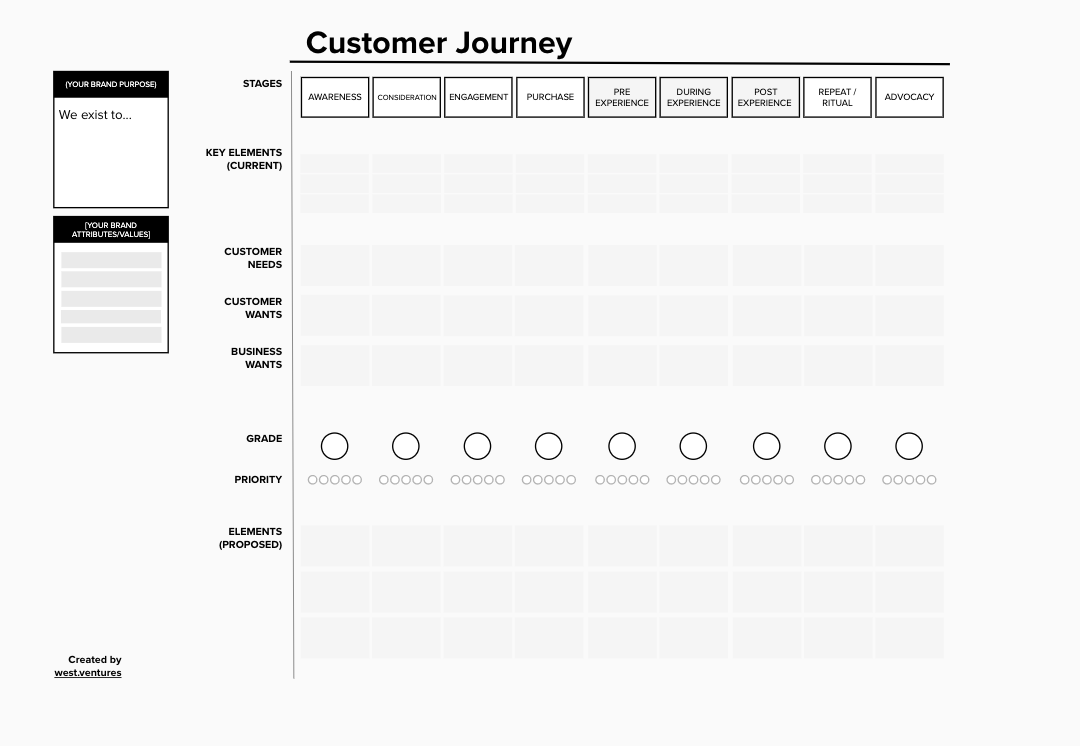If you’re like any of the founders and teams I’ve spoken to in the last week, you probably fall into one of the following four groups – 1) Feeling defeated (change is so hard; it was so perfect before!) 2) Feeling stuck working on another draft of yet another update email while the world continues to change faster than you can type 3) Feeling a random, aimless shuffling of your business elements like a Rubik’s cube or 4) (If you’re lucky) Feeling fortunate that your product is now even more desirable.
We understand. Know that for almost everyone this is hard - really, really hard.
Whatever group you fall into, our advice is to revisit the basics, starting with your customer’s perspective - by mapping their journey. Unlike a Product Roadmap, a Customer Journey Map examines every moment across your entire product and brand experience, specifically zeroing in on the elements that meet the needs and wants of your customers and your business. It’s a technique and exercise that allows you to take a wide aperture view of every part of your business––helping your organization become more fluid, adaptable, and delivering immediate value to your end customers.
So why now? Over the past few weeks, every single customer experience has shifted. These shifts will carry on for the foreseeable future. It’s too early to predict the “new normal” and any grand re-write will only be temporary at best. Right now, your customers need a brand that can deliver on and respond to their changing needs. Zero-ing in on the small steps and moments allows you to react on a much more nuanced level, consider multiple perspectives, and most importantly, account for your customer at every step.
Customer Journey Maps are actually CEO dashboards
This isn’t a marketing-only exercise. Over many years working alongside our studio and portfolio companies, I’ve been surprised to see hundreds of Product Roadmaps but comparatively very few complete Customer Journey Maps. For those that do have them (it’s often the more successful companies that do), this map often serves as the CEO’s dashboard, ensuring they are steering the business forward with the customer always at the center. When done right, they become effective decision trees for entire teams and organizations, the rationale for deciding where resources are allocated, and the reason for marketing, product, and experience changes.
Conversions, frequency, advocacy, engagement, and loyalty are just a few of the things that a holistic and well-thought-out Customer Journey Map can deliver. The theory is that every element you choose to outline on this journey should be created and designed to deliver value and delight, remove friction, and build your brand overall. The more detailed you make brand and product moments (and critically, the spaces between them), the more unique, thoughtful, and impactful the journey you create for customers. If you’re only focused on one area or moment, (just the conversion moment or just the mission-critical), you are most likely missing most of the moments that create a beloved brand and a healthy, well-rounded business. Right now, this is more important than ever.
Widen your aperture with a Customer Journey Map
| Too focused on purchase. | Too focused on product. | Too focused on conversion. | Only doing the minimum. |
Okay, so how do I create one?
If you have never made a journey or don’t know where your last one is (!), we created a quick template to get you (re-)started. It can be used as a starting point for any customer journey (and the basis of the one the West team often references when working on Journey Maps for our own studio partners and portfolio companies). On the template, you’ll see an area to add your brand’s purpose and pillars. Remember to reference these pillars throughout in order to infuse each element of the journey with your unique brand. If one of your pillars is “Trusted”, how can you translate moments of trust to the customer’s experience?
To help organize your initial efforts, we’ve also included a few rows to grade and indicate priority for each moment.

Acknowledging that this week was entirely different from last month, as you walk through this exercise either by yourself or with your team, consider how the following questions and themes might change or alter from your original vision:
Underlying Brand:
- What is now irrelevant or unrealistic?
- What do we need to stop, pause, change?
- What are our customers saying and asking for? (ask them!)
- In what ways and for what moments can we really show our purpose and what we stand for?
Customer Engagement
- How can we maintain or encourage community engagement?
- How can we replace the awareness and engagement we received from offline events?
- In what new ways should advocacy be encouraged without physical word-of-mouth?
- For what moments can we add real human interactions?
Customer Experience
- Are our packaging and onboarding experiences considered and relational?
- What new routines and rituals can we create, model and encourage?
- How can we respond to their current needs and wants?
Lastly, don’t give up – you might be surprised what your brand can become for customers in these new times.
-Jeremy Lind, Managing Director


No Comments.